Tracing our Lacemakers and Immortalising them in Song
“We hold invisible hands with those
Who have gone down in history
We cannot let go
They are holding us.”
Martin Wroe
International Women’s Day 2021
Today, we think of all the women in our lives who have nurtured, encouraged, supported, inspired and shared their innate wisdom with us and all the women who continue to do so. The focus of this blog is about the lives of the women in our local area who were involved in the lace industry lest they be forgotten.
Firstly, it is important to understand the jaw-dropping value of lace: in the book Patch Work: A Life Amongst Clothes, Claire Wilcox, Senior Curator of the V&A says "In its heyday lace was an economic miracle, weight for weight, thread for thread; more valuable than gold". Lace was a status commodity, much sought after by the privileged classes; however the lacemakers were not well remunerated for this difficult work in poor circumstances.
Since its inception five years ago, the Headford Lace Project has been taken on a journey of discovery. The historical threads of the local lacemakers have unravelled before our eyes revealing an incredible history extending back to c.1745. Committee member and researcher, Norma Owens has painstakingly sought to trace the names of the lacemakers and the patrons of the lace industry in Headford.
The Patrons of Lace
The women of the local landowning St. George family were instrumental in the setting up and supporting the lace industry and were referred in much of the literature as "Mrs. St. George". Olivia Ussher St. George French set up a spinning school in the town c.1745 as flax was widely grown in the area. Mary/Molly St. George established the lace industry in c.1765 and was described as "an unimaginative woman" - hardly the case as Mary afforded the local women independent means. She was the natural/illegitimate child of Lieut. Gen. Richard St. George and went on to inherit Headford Castle and the estate. The lace industry thrived and many hundreds were employed in lacemaking in the 1800s. The only portrait of the women of the family found to date is of Anne Stepney, wife of Richard St. George Mansergh St. George. Sittings for this portrait started on 21st July 1791 and depicts Anne with her son, Richard James. The artist was George Romney. Anne is pregnant with her second son Stepney and she died in August 1792.
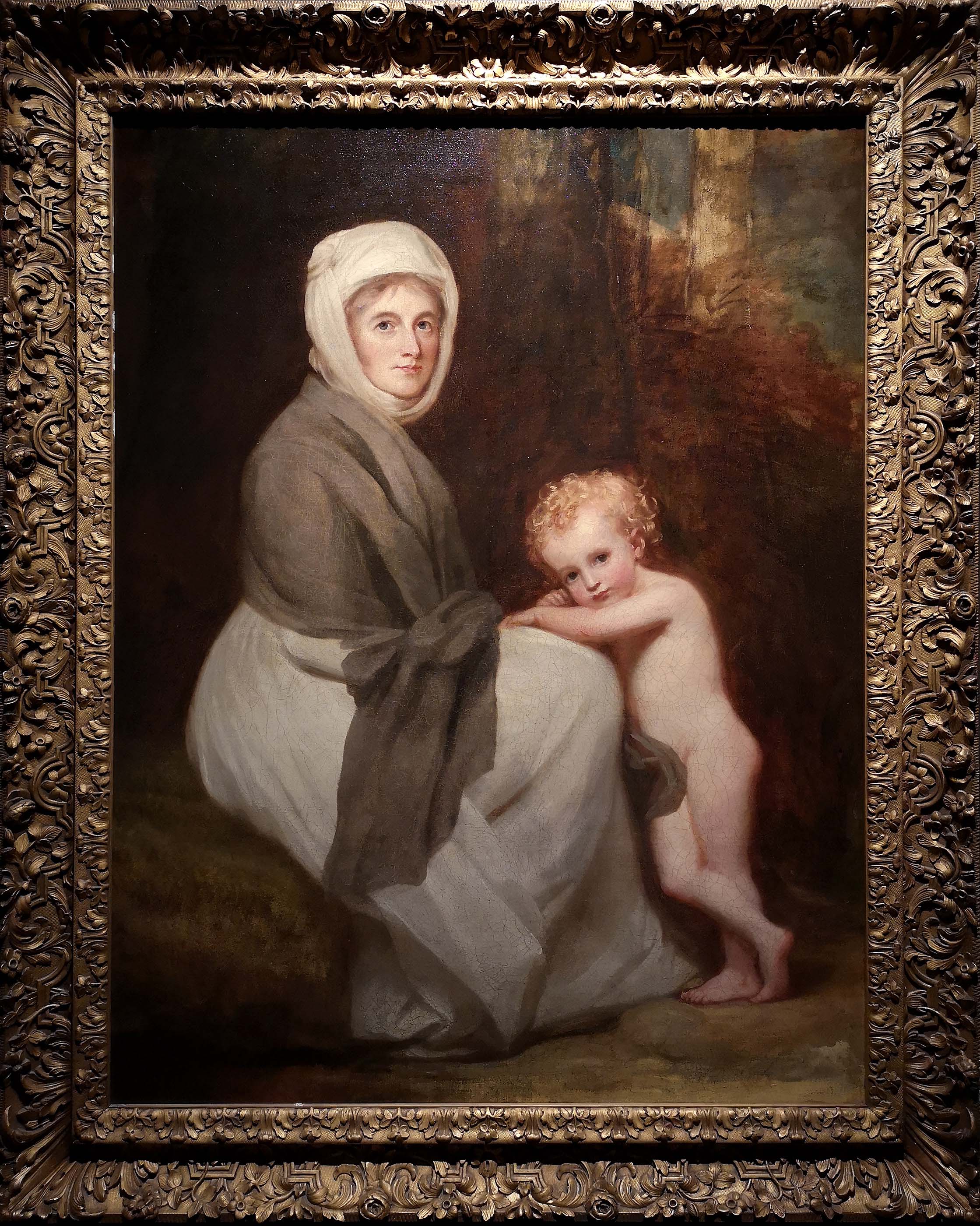 'Mrs. Anne St. George and Child' (1791) by George Romney. From the collection of The Hecksher Museum of Art and photographed at the 'Cost of Revolution: The Life & Death of an Irish Soldier' exhibition at the Museum of the American Revolution.
'Mrs. Anne St. George and Child' (1791) by George Romney. From the collection of The Hecksher Museum of Art and photographed at the 'Cost of Revolution: The Life & Death of an Irish Soldier' exhibition at the Museum of the American Revolution.
In an inquiry into the living conditions of the poorer classes in 1835, we find that "there were 35 widows living in the Headford, of whom 17 lived rent free and earned their living as lacemakers" and got a good deal of assistance from Mrs. St. George, Elizabeth Sophie St. George née Shaw. Although they were living in poverty, they were not destitute. In 1847, both the Queen Dowager Adelaide and Queen Victoria ordered 20 pounds worth of Headford Lace. This must have been a great boost to the lacemakers during the famine. Mrs. Julia Jackson née de Villiers was praised "for her successful efforts to revive our hitherto neglected lace manufacture" in 1849. Julia was the wife of the local Church of Ireland Rector. Married to the local land agent for the St. George family, Catherine Hunt née Powell became patron of the Normal Lace School, which was established in Headford by the Ladies Irish Industrial Society in 1852.
By employing the technique of photogrammetry, Norma has established that Frances St. George née L’Estrange is buried in the graveyard at the Church of St. John the Baptist, Headford, where the lace garden is situated. This fact had not been noted previously. Her tomb is now on our tour Walking in the Footsteps of the Lacemakers.
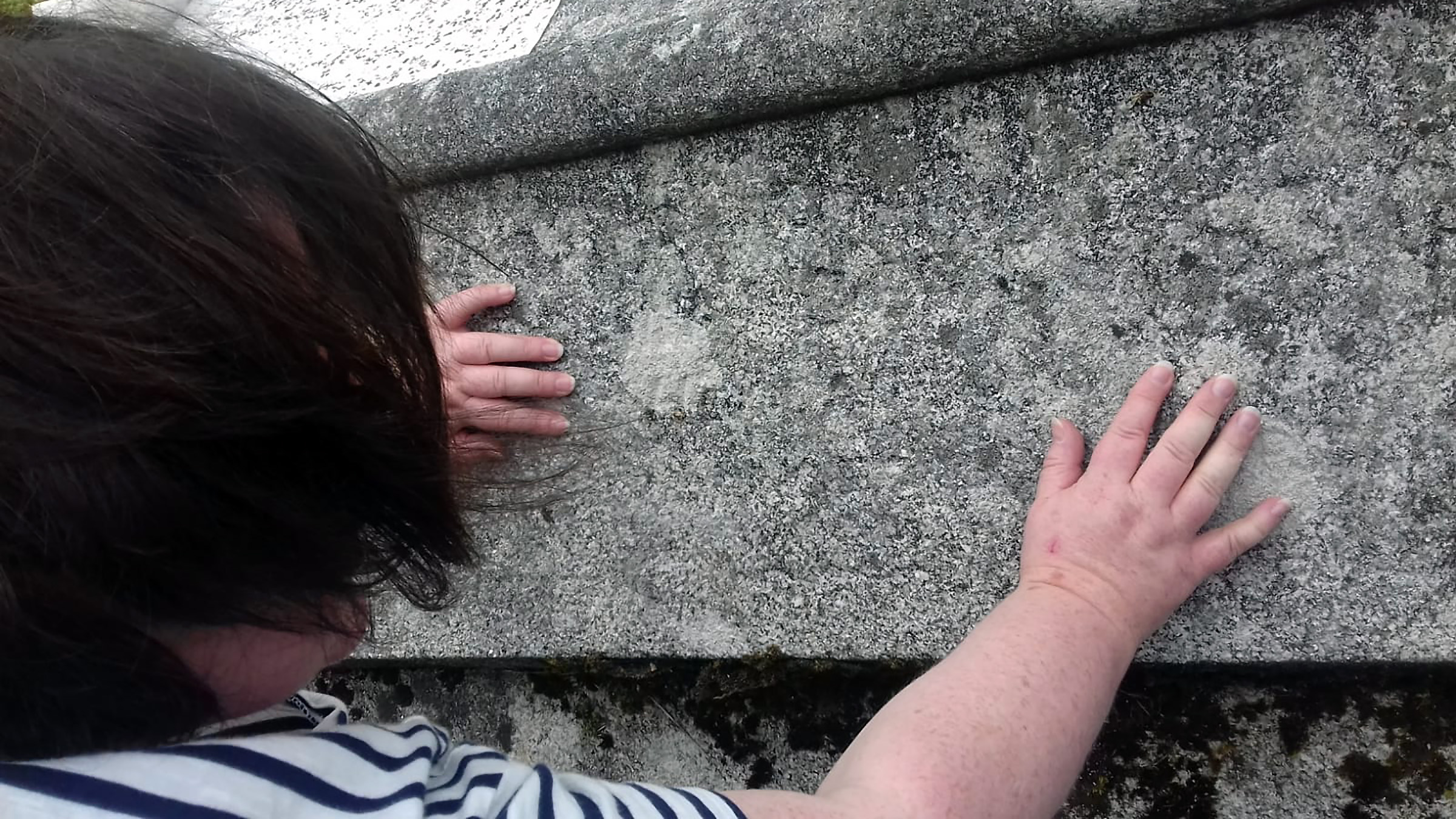
Norma Owens examining the St. George gravestone in Headford
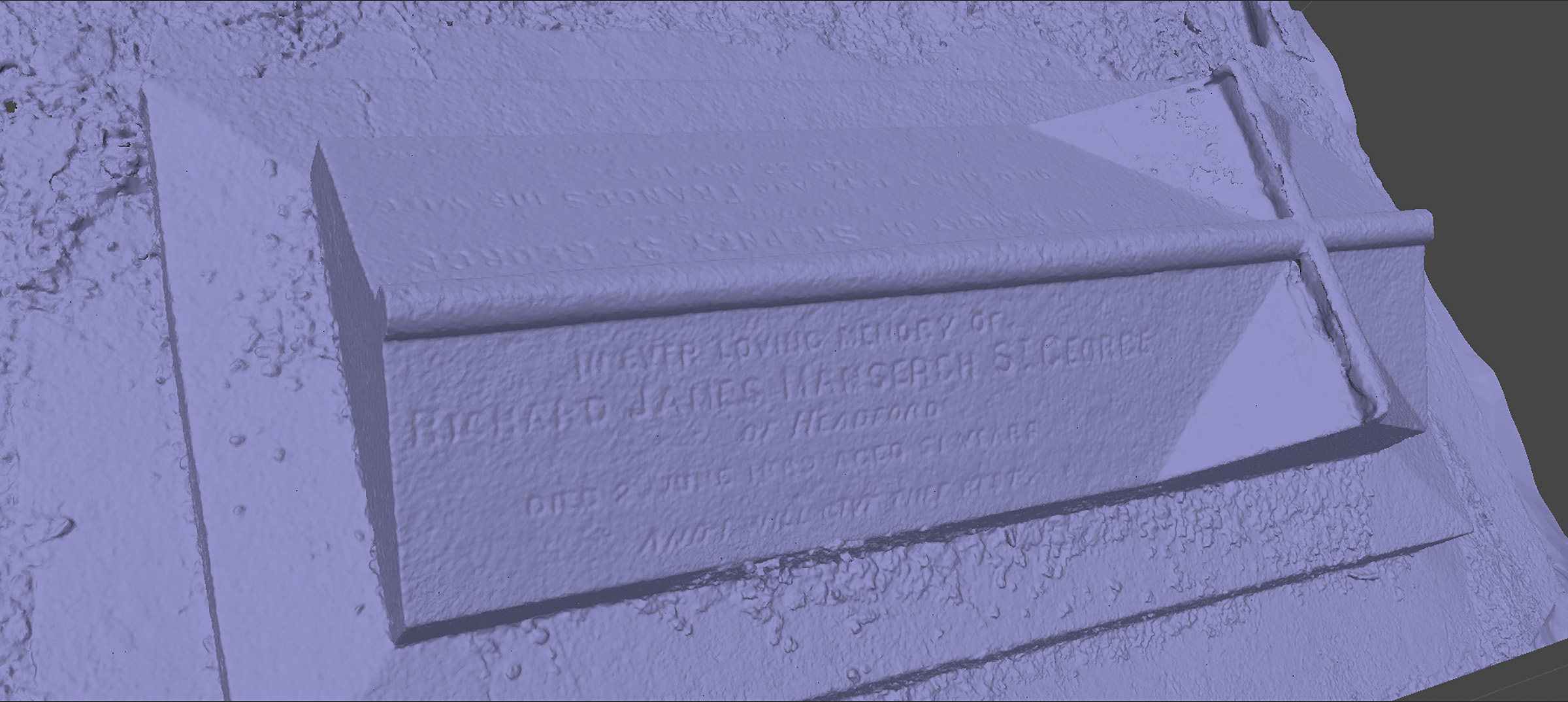
Photogrammetric model of the St. George gravestone reveals an inscription not visible to the naked eye.
The Freeman’s Journal of 30th December 1861 stated that "Mrs. St. George of Headford Castle, with her own hands distributed a great deal of charity on Christmas Eve, both in meat, money and coal. She did not leave it to be done by the cormorants who would devour it themselves as heretofore". This was Mary Agatha St. George née Henley. The Tuam Herald 14th March 1891 noted that Mrs. St. George (Agatha) "is dealing fairly with the tenantry" as the estate was being divided. We also know from a local testimonial that Mrs. St. George "brought lace to London and sold it for the lacemakers", thus cutting out the middlemen.
Tracing the Lacemakers
In an account of County Galway, written in 1790 by Mary’s son, Richard St. George Mansergh St. George, he noted that "the women at Headford make Lace". In 1845 and 1861 there are idyllic descriptions of "neatly dressed girls sitting on low stools, their pillows on their laps" outside the cottages. The reality was somewhat different, as cottages were dark and natural daylight was necessary for this detailed work. Not ideal in the cold wet conditions of the west of Ireland. However, committee member Ella Hassett discovered that a Mrs. Burke, Headford, submitted a piece of 'Headford Lace', a lace in its own right, to the 1887 Royal Jubilee Exhibition in Manchester under the Women’s Industries section. A hospital record from 1890 noted the occupation of Bridget Hogan from Headford as a lacemaker. Census records from 1901 revealed Sarah Walsh, Anne Hogan, Margaret Higgins, Julia Casey, Margaret Casey and Catherine Parker and the 1911 census provided the name Ellen Keane. An additional three women were recorded on the Headford Agricultural Show catalogue of 1910 having entered the Headford Lace Category and they were Honor Melia, M. O’Shaughnessy and Mary Connell. On the 1913 catalogue, a Mary Reddington is listed. A married woman’s occupation was not always recorded on the census, as the man was head of the household. However, if the woman was unmarried or widowed it was recorded. We are also delighted to have two photographs one of Honor Melia and the other of Catherine (Kate) Parker.
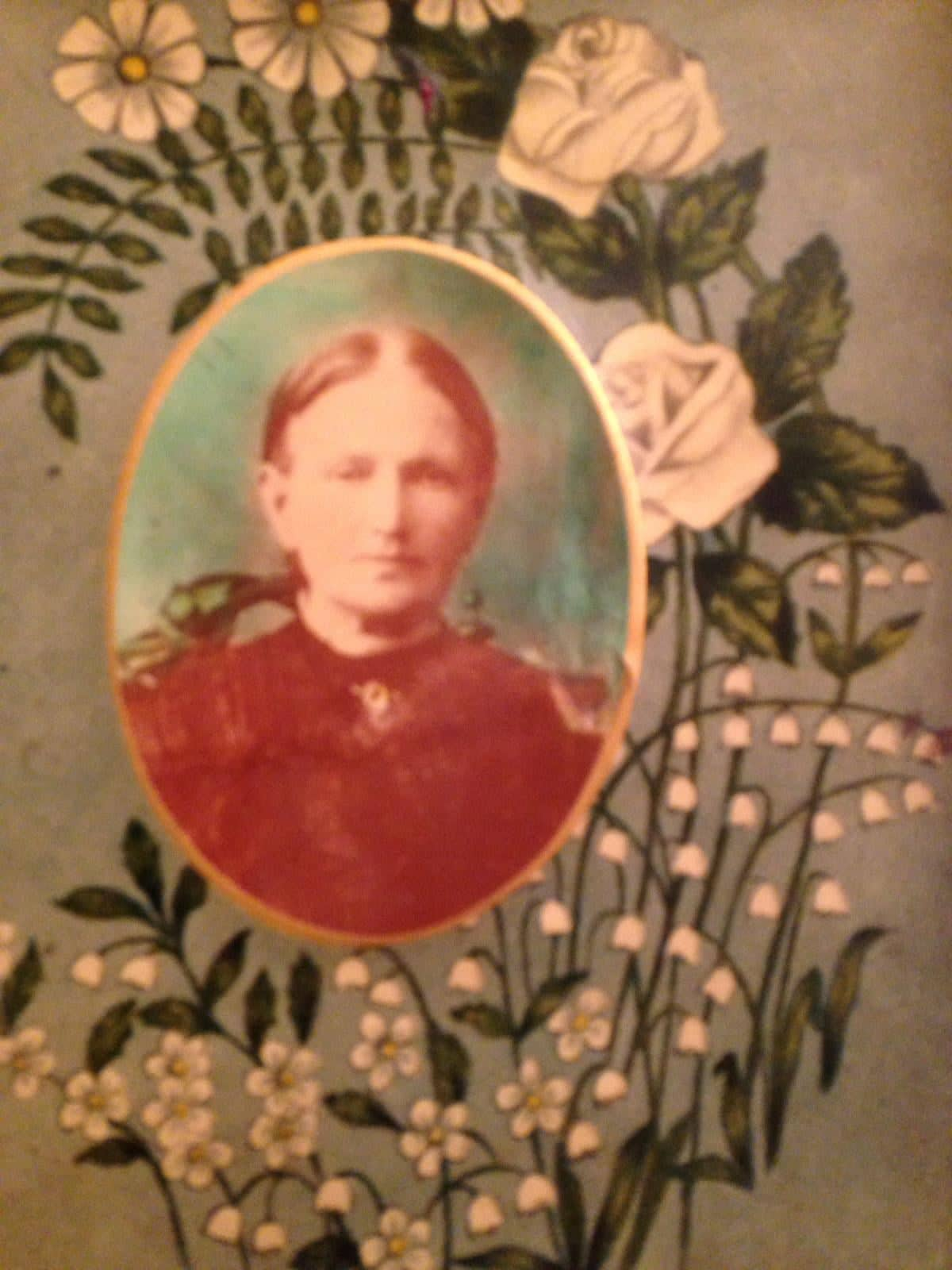
Catherine (Kate) Parker née Burke was known as a lacemaker by her family. This photograph was presented by her great granddaughter, Brega Webb.
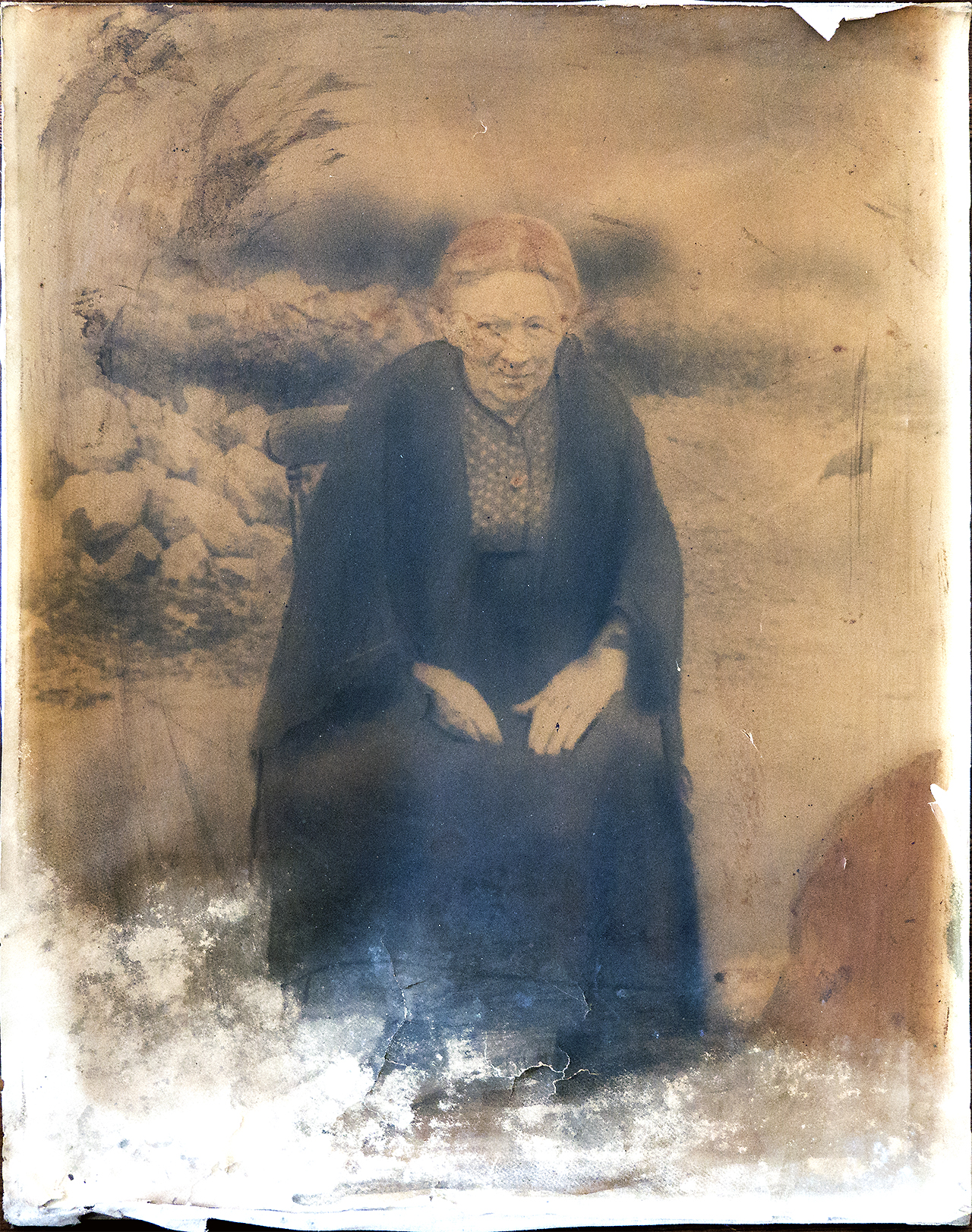
Honor "Nan" Malie, a lacemaker who lived on New Street. She died in 1931 at the age of 108. In 2018, Nora Gildea, a relative who lived at the same house on New Street, described the bobbins found in the house as like pencils, but tapered so that they were thicker at one end. This photograph was kindly donated to the Headford Lace Project by Rita Gildea.
Immortalised in Song
Headford Lace Project is overjoyed that as a result of a collaboration with local folk group, The Whileaways, the memory of the lacemakers has been immortalised in the song, 'Toss the Bobbin'. This was possible due to support from Sharon O’Grady, Galway County Council Arts officer and funding through the Galway County Council Community Supports Grant 2019. Initially, The Whileaways recorded 'Toss the Bobbin' at the Black Gate Studio in Galway. Last year, The Whileaways were invited by RTÉ to have three of their original songs arranged for orchestra. 'Toss the Bobbin' was selected by arranger, Oisín Walsh Peelo, who was greatly taken with the song and the story of the lacemakers. It was aired on October Bank Holiday Monday and again on Christmas Eve. It will be featured on their new album, due to be released this year. It is very emotional for the members of the Headford Lace Project to have these women remembered in song. We look forward to a live performance in 2021.
Whileaways songwriter Nicola Joyce, who is a Headford native, was particularly moved by the story of the lacemakers: "Having grown up in Headford, it was astounding to me that none of the members of my family, nor myself ever knew anything of the existence of Headford lace and that this fascinating story of the women of our area had been almost entirely forgotten. The nuns had taught us how to make Mountmellick lace at primary school, but there was never a word about Headford lace. It seems they simply didn't know about it. Had it been the work of men, it's hard to imagine that it may have fallen so far into insignificance. When I eventually learned of the history of Headford lace thanks to the extensive research of HLP, I was blown away and found the whole story very emotional. I couldn't help but imagine these women, my ancestors, and their daily lives. The time, the care and the skill that went into making these delicate pieces of lace, only to be paid a pittance, knowing all the while that they would never themselves wear something so beautiful. It was destined for the more fortunate, the women of means who were desperate to show their wealth and status and would never think twice of the hands in Headford who made it. To me it's a story of resilience, ingenuity and sisterhood and it has been an honor to give voice to these almost forgotten women."
Click here to hear 'Toss the Bobbin' played by The Whileaways and the RTÉ Concert Orchestra.
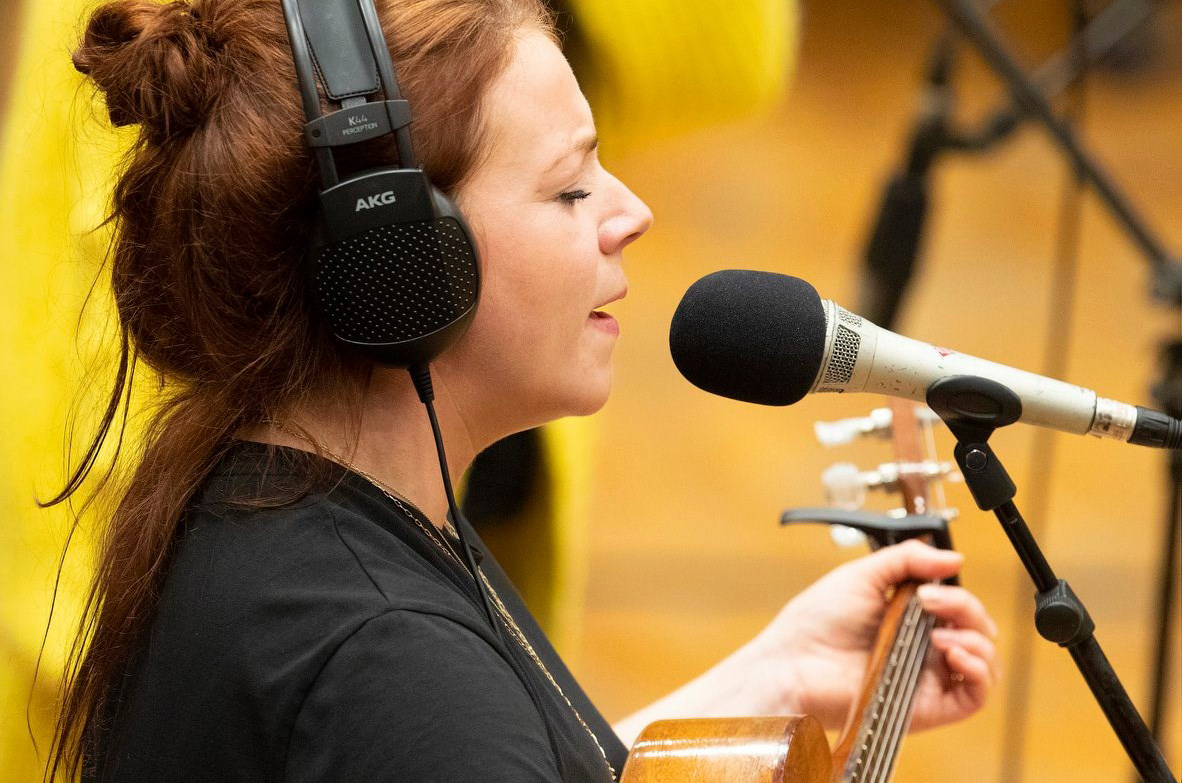
Nicola Joyce, songwriter and singer with 'The Whileaways'
